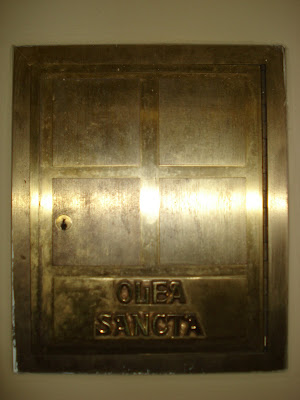 Often in older churches you will see a little brass door in the side of wall with the words, “Olea Sancta” or “Holy Oils.” It is called the Ambry or sometimes Aumbry. Here the holy oils that are blessed at the Chrism Mass are kept. Larger ambries also might hold the parish relics or even certain liturgical books.
Often in older churches you will see a little brass door in the side of wall with the words, “Olea Sancta” or “Holy Oils.” It is called the Ambry or sometimes Aumbry. Here the holy oils that are blessed at the Chrism Mass are kept. Larger ambries also might hold the parish relics or even certain liturgical books.In more recent times with tabernacles on side altars no longer housing the Blessed Sacrament many parishes have begun using one or the other as the ambry for the holy oils. It seems to become quite the thing to have a glass ambry made today and to store the oils in such a fashion so that they may always be seen by parishioners. This might be a good thing as it makes more people aware of the oils and their use. Often the ambry was not visible from the main body of the church.
There is one note of caution however. The oils are not meant to just be displayed but used in a sacramental manner. Often it seems a parish will obtain a very large quantity of oil and store them in glass stocks (the container used for storing oils) mostly for show purposes. In a far greater quantity than is ever expected to be used the oil is then purposefully wasted. The oil is not a show piece but a sacramental tool expected to be used. There then comes the problem of disposing of the old oils at the end of the year when they must be buried, burned, or otherwise properly disposed of.

No comments:
Post a Comment